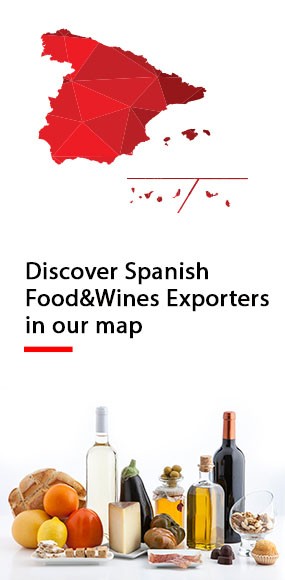.png.transform/rendition-xs/image_image%20(1).png)
The Wines from Spain in The Americas’ Top Rests
Foods from the world pair well with wines from Spain
A reason for the global success of wines from Italy is the very large network of Italian restaurants around the globe. Spanish restaurants outside of Spain have also been a very important platform for the dissemination of a wine culture around the wines from this country.
Even though they are less abundant than those from Italy, one of the most competitive advantages of the wines from Spain is their food friendliness and aptitude to harmonize a large assortment of global flavors and ethnic cuisines.
As a result of globalization and a consumer’s curiosity to discover a great diversity of cultures through food, gastronomy has become a key tourist attraction, and local restaurants have worked their ways up to excellence through the development and enhancement of innovative culinary experiences based on their indigenous flavors and culinary traditions. This formula has brought some restaurants to the pinnacle of culinary excellence, and in this effort their wine cellars are strong pillars and a place where to consecrate new and well known wine labels among their diners.
The sommeliers of this new savor temples tell www.foodswinesfromspain.com what’s the role of the wines from Spain in the exciting equation of surprising and pleasing consumers through food and wine.
Gregory Smith. General Manager and Head Sommelier. Central (Lima, Perú)
In the last decade, Perú has captured attention of the food and wine world, which made this South American country, proud of its heritage and biodiversity, one of the trendiest global food destinations.
Responsible for this emergence is a group of young Peruvian chefs, many trained in Spain, among whom Virgilio Martínez is perhaps the most prominent talent. His creative and avant-garde exploration of least known Peruvian ingredients from the Andes, the Amazon or the country’s coast has earned his restaurant Central accolades as Latin America’s top fine dining establishment and the 4th in the world, and, therefore, an extraordinary showcase for wine.
Complementing Virgilio’s talent in the kitchen is Gregory Smith, an American from Kentucky who landed in Lima years ago and is the chef’s right hand, manager of the restaurant and responsible not only for its exciting wine and liquor cellar, but also for a hard work to promote the professionalization of sommeliers in Perú, and the expansion of wine culture in the country.
Central’s bold and innovative flavors and textures, with a strong sense of geographical and historical essence, expressed with elegance and creativity, are the focus of the restaurant’s wine selection, of which 12% consists of wines from Spain.
According to Smith, refreshing acidity, lower alcohol content and well integrated alcohol in wines that cleanse the palate or make a discrete use of oak are traits that work well with Central’s cuisine and make many wines from Spain good pairing choices for some of the menu’s proposals. Albariño from Rías Baixas, Cava blends and some Tempranillos from Rioja and Ribera Del Duero fit well in that context.
Smith explained to www.foodswinesfromspain.com that wines incorporated in Central’s wine list must be either capable of pairing some of the dishes in the menu, a style the restaurant’s clientele looks after, or a style the team of sommeliers likes to recommend. Sparkling Raventós i Blanc De la Finca is precisely a label the sommelier chose to pair two dishes of the tasting menu: Colors of Amazonia, and Harvest and Collection.
“We always include one or two chefs in the process of selecting wines to accompany the tasting menu,” added the sommelier, who has visited Penedès, Ribera Del Duero, and Rioja and chooses Rioja DOQ Muga Aro 2006 as his unforgettable wine from Spain.
Dry, white, rosés, reds, sparkling and fortified wines from across Spain are found in a cellar with bottles embracing Andalusian Jerez DO, Rioja, Bierzo and Ribera Del Duero in Castile-León, Murcian Yecla, Galician wines from Rías Baixas and Monterrei DOs, Vinos de la Tierra de Extremadura, Wines from La Mancha, even Dominio de Valdepusa DO, and a variety of Catalan wines from Costers del Segre, Pla de Bagés, Priorat, Terra Alta, and, of course, sparkling Cava.
Central also carries wines by the glass and among those from Spain that can be poured in smaller portions currently are Raventós sparkling, Aecovi Manzanilla Alexandro, Fino Tío Pepe, Xare-lo Miranius, Carmelo Rodero 9 Meses and Carmelo Rodero Pago de Valtarreña in Ribera Del Duero. Central’s wine list is very dynamic and in constant evolution.
80% of the restaurant’s clients are tourists and visitors, which means the restaurant provides an excellent platform to showcase the wines from Spain to discerning prospect consumers from all over the world.
Martínez also runs Lima London in the United Kingdom.
Pablo Mata, Sommelier. Marianna Ramírez, Beverage Director. Pujol (Mexico DF)
Beyond the stereotype of tacos, Mexican cuisine has a rich centuries-old history, a heritage distinguished by the UNESCO for its vibrant present and authenticity.
Foremost among the Mexican chefs who have taken advantage of this history of ingredients is Enrique Olvera, who leads Pujol in Mexico City and Cosme, in New York City. Ranked as 9th best restaurant in Latin America and the 16th in the world by Restaurant Magazine, Pujol has been the scenery where Olvera has successfully portrayed a contemporary version of Mexico’s cuisine.
Although the wine offer varies seasonally to complement the often changing menus, a year-long average of 10% of the wines served in the restaurant come from Spain, an offer well managed by sommelier Pablo Mata, and Beverage Director, Marianna Ramírez.
Mata is a Mexican wine professional with a comprehensive experience and understanding of the wine sector, in which he has worked as sommelier, professor, and sales & marketing specialist in restaurants, wine bars, academic centers and culinary schools, as has also been trained in culinary arts, something that has provided valuable expertise for food and wine pairings. He is a specialist in Sherry wines, certified by the Jerez-Xérèz-Sherry DO, has various certifications from the Court of Master Sommeliers, and is regularly involved in the coordination of stellar food and wine events in Mexico.
Verdejos from Rueda and Albariños from Rías Baixas are the white selections on the wine list, which on its red side has a larger red proposal featuring Garnachas from Rioja and Madrid, Tempranillos from Rioja, Ribera Del Duero and Toro, and fortified Sherry wines. Wines from Spain by the glass are available.
Mata explained to www.foodswinesfromspain.com a wine’s quality, elegance and ability to harmonize with Pujol’s seasonal menus are the main considerations to determine whether to incorporate or not a wine label onto the wine list. “Wines must be subtle, medium-bodied, not overwhelming, with good acidity, complex and long-lasting in the palate,” he told, indicating that the wine list is a result of teamwork between the chef and the restaurant’s beverage team.
Pujol does not offer pre-conceived wine pairings, because its menu is very flexible, built on the ingredients available in the market. This forces the wine list to be dynamic too. Nevertheless, Mata said that one of their favorite food and wine pairings is that of Ribera Del Duero’s Casajús Vendimia Seleccionada with their Chicken with Romeritos and Nopales.
The sommelier indicated that because of their popularity and confirmed quality Rías Baixas and Ribera Del Duero are Spain’s wine designations of origin preferred by Pujol’s clientele, formed in 95% by foreign visitors. Although he hasn’t yet visited Spain, he does have a Gran Reserva wine from the 1985 vintage of La Rioja Alta winery as his unforgettable wine from the country.
According to Mata, the affordability of the wines from Spain and their consistent quality are their most important attributes. To help consumers discover the broader spectrum of the country’s wine producing zones is what he considers a top challenge for the wines from Spain in Mexico.
Aldo Sohm. Wine Director. Le Bernardin (New York)
Born and trained in France, raised in Andorra, and very familiar with Spanish, Caribbean and Latin American flavors because of friends and family ties, Chef and TV personality Eric Ripert has brought seafood to a new zenith, and has made flavors from the sea a column of internationally acclaimed fine dining icon Le Bernardin, a three Michelin starred restaurant in New York City that has consistently also attained New York Times four star rating. Le Bernardin was born in Paris in 1972 and opened its New York location in 1986.
Wine is an essential component of Le Bernardin’s excellence. The restaurant offers a dynamic wine selection that is reviewed bi-weekly. “Our list changes frequently so while we currently don’t have one label this week, we may have one or two wines from Spain the next,” told Aldo Sohm, Le Bernardin’s Wine Director-Chef Sommelier to www.foodswinesfromspain.com According to Austrian-born Sohm, wines from Spain represent approximately 10% of the labels available in the cellar. Le Bernardin has a collection of 15,000 bottles made up of 900 wine selections from 12 countries and vintages dating back to 1945.
The sommelier, who also leads Aldo Sohm Wine Bar in Manhattan, joined Le Bernardin in 2007, the year he was distinguished as “Best Sommelier in America”, a title that he extended to a global reach when in 2008 was voted “Best Sommelier in the World”. Under his leadership Le Bernardin received the James Beard Award for Outstanding Wine Service” in 2009.
Le Bernardin’s wine program focuses on pairings that complement Ripert’s cuisine, based mostly on seafood. Sohm and Ripert discuss Le Bernardin’s wine selection regularly, an opportunity the sommelier takes to introduce the chef to new wine regions and grape varietals from the world.
“I always look at the new dish, its sauce, and what style or type of wine could pair perfectly. Overall, I think Spanish wines offer many styles that fit a broad variety of cuisines,” Sohm added.
Labels from Rioja, Ribera Del Duero, Rías Baixas, Bierzo, Rueda, Priorat, Catalunya and Jerez are currently featured on the wine list, and wines as La Val Albariño, from Rías Baixas DO, and Matias I Torres Listán Blanco from the Canary Islands are available by the glass. Pago de los Capellanes, Fino Inocente, La Bota de Fino, Vega Sicilia, Raventos i Blanc, and Corullón are a few of the wine labels from Spain that can be found at Le Bernardin.
“The wines from Spain that we feature on the list all perform well. Some, like Riojas or Priorats, are more popular because of name recognition, and others for their tasting profile,” he explained.
The restaurant, whose diners are a mix of New Yorkers and visitors from around the world, also offers wine pairings for both the Chef’s Tasting and Le Bernardin Tasting Menus. In this harmonious exercise, sparkling Cava evalidates as a versatile pairing, as in the case of their “Lobster” Lasagna, served with Celeriac and Truffle Butter, which is paired with a cava from Agustí Torelló Mata.
Sohm, who has not yet visited Spain, has a López de Heredia Gran Reserva 1964 as his very memorable wine from Spain.
A reason for the global success of wines from Italy is the very large network of Italian restaurants around the globe. Spanish restaurants outside of Spain have also been a very important platform for the dissemination of a wine culture around the wines from this country
Rosa María González Lamas/©ICEX



- The Wines from Spain
- The Wines from Spain
- The Wines from Spain

